YOLOv8目标检测创新改进与实战案例专栏
专栏目录: YOLOv8有效改进系列及项目实战目录 包含卷积,主干 注意力,检测头等创新机制 以及 各种目标检测分割项目实战案例
专栏链接: YOLOv8基础解析+创新改进+实战案例
介绍

摘要
视觉识别的“咆哮20年代”开始于视觉Transformer(ViTs)的引入,ViTs迅速取代了卷积神经网络(ConvNets)成为最先进的图像分类模型。然而,普通的ViT在应用于诸如目标检测和语义分割等一般计算机视觉任务时面临困难。分层Transformer(例如Swin Transformer)重新引入了几种ConvNet先验知识,使得Transformer在实际应用中成为通用的视觉骨干,并在各种视觉任务中表现出色。然而,这种混合方法的有效性很大程度上仍归因于Transformer的内在优势,而不是卷积的固有归纳偏差。在这项工作中,我们重新审视了设计空间,并测试了纯ConvNet的极限。我们逐步将标准的ResNet“现代化”,朝着视觉Transformer的设计方向发展,并在此过程中发现了几个关键组件,这些组件对性能差异有贡献。经过这一探索,我们推出了一系列纯ConvNet模型,命名为ConvNeXt。这些模型完全由标准的ConvNet模块构建,与Transformer在准确性和可扩展性方面竞争,达到了87.8%的ImageNet top-1准确率,并在COCO检测和ADE20K分割中超过了Swin Transformer,同时保持了标准ConvNets的简单性和效率。
文章链接
论文地址:论文地址
代码地址:代码地址
基本原理
Transformer在视觉领域大放异彩?以后卷积怎么办呢?facebook 的研究人员就探究了这样一个问题。首先,SwinTransformer采用分层和窗口的设计,取得了非常好的性能。这说明卷积这种窗口的设计也是有用的,因此,研究人员通过对比卷积和Transformer的体系结构,设计了ConvNext。
(1)提升感受野,使用更大的卷积核(33–>77),但是更大的卷积核带来了更多的运算量,这就需要使用1*1的卷积调整通道和分组卷积了。
(2)将ReLU替换为GeLU,并设计了一个类似于Transformer的FFN层的结构,即在两层1*1的卷积中间使用激活函数
(3)归一化由BN变为LN,并类似于Transformer,使用更少的归一化层。
(4)降采样层:类似于Swin Transformer,使用2*2的卷积,stride为2,并使用LN稳定训练。
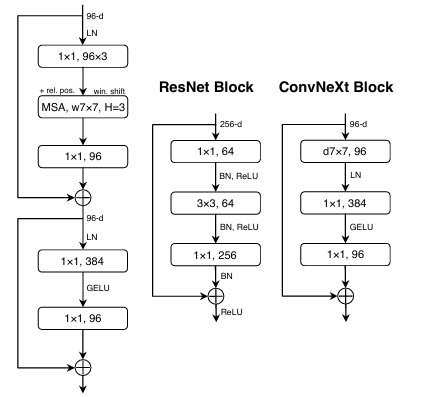
核心代码
# Copyright (c) Meta Platforms, Inc. and affiliates.
# All rights reserved.
# This source code is licensed under the license found in the
# LICENSE file in the root directory of this source tree.
import torch
import torch.nn as nn
import torch.nn.functional as F
from timm.models.layers import trunc_normal_, DropPath
from timm.models.registry import register_model
class Block(nn.Module):
r""" ConvNeXt Block. There are two equivalent implementations:
(1) DwConv -> LayerNorm (channels_first) -> 1x1 Conv -> GELU -> 1x1 Conv; all in (N, C, H, W)
(2) DwConv -> Permute to (N, H, W, C); LayerNorm (channels_last) -> Linear -> GELU -> Linear; Permute back
We use (2) as we find it slightly faster in PyTorch
Args:
dim (int): Number of input channels.
drop_path (float): Stochastic depth rate. Default: 0.0
layer_scale_init_value (float): Init value for Layer Scale. Default: 1e-6.
"""
def __init__(self, dim, drop_path=0., layer_scale_init_value=1e-6):
super().__init__()
self.dwconv = nn.Conv2d(dim, dim, kernel_size=7, padding=3, groups=dim) # depthwise conv
self.norm = LayerNorm(dim, eps=1e-6)
self.pwconv1 = nn.Linear(dim, 4 * dim) # pointwise/1x1 convs, implemented with linear layers
self.act = nn.GELU()
self.pwconv2 = nn.Linear(4 * dim, dim)
self.gamma = nn.Parameter(layer_scale_init_value * torch.ones((dim)),
requires_grad=True) if layer_scale_init_value > 0 else None
self.drop_path = DropPath(drop_path) if drop_path > 0. else nn.Identity()
def forward(self, x):
input = x
x = self.dwconv(x)
x = x.permute(0, 2, 3, 1) # (N, C, H, W) -> (N, H, W, C)
x = self.norm(x)
x = self.pwconv1(x)
x = self.act(x)
x = self.pwconv2(x)
if self.gamma is not None:
x = self.gamma * x
x = x.permute(0, 3, 1, 2) # (N, H, W, C) -> (N, C, H, W)
x = input + self.drop_path(x)
return x
class ConvNeXt(nn.Module):
r""" ConvNeXt
A PyTorch impl of : `A ConvNet for the 2020s` -
https://arxiv.org/pdf/2201.03545.pdf
Args:
in_chans (int): Number of input image channels. Default: 3
num_classes (int): Number of classes for classification head. Default: 1000
depths (tuple(int)): Number of blocks at each stage. Default: [3, 3, 9, 3]
dims (int): Feature dimension at each stage. Default: [96, 192, 384, 768]
drop_path_rate (float): Stochastic depth rate. Default: 0.
layer_scale_init_value (float): Init value for Layer Scale. Default: 1e-6.
head_init_scale (float): Init scaling value for classifier weights and biases. Default: 1.
"""
def __init__(self, in_chans=3, num_classes=1000,
depths=[3, 3, 9, 3], dims=[96, 192, 384, 768], drop_path_rate=0.,
layer_scale_init_value=1e-6, head_init_scale=1.,
):
super().__init__()
self.downsample_layers = nn.ModuleList() # stem and 3 intermediate downsampling conv layers
stem = nn.Sequential(
nn.Conv2d(in_chans, dims[0], kernel_size=4, stride=4),
LayerNorm(dims[0], eps=1e-6, data_format="channels_first")
)
self.downsample_layers.append(stem)
for i in range(3):
downsample_layer = nn.Sequential(
LayerNorm(dims[i], eps=1e-6, data_format="channels_first"),
nn.Conv2d(dims[i], dims[i+1], kernel_size=2, stride=2),
)
self.downsample_layers.append(downsample_layer)
self.stages = nn.ModuleList() # 4 feature resolution stages, each consisting of multiple residual blocks
dp_rates=[x.item() for x in torch.linspace(0, drop_path_rate, sum(depths))]
cur = 0
for i in range(4):
stage = nn.Sequential(
*[Block(dim=dims[i], drop_path=dp_rates[cur + j],
layer_scale_init_value=layer_scale_init_value) for j in range(depths[i])]
)
self.stages.append(stage)
cur += depths[i]
self.norm = nn.LayerNorm(dims[-1], eps=1e-6) # final norm layer
self.head = nn.Linear(dims[-1], num_classes)
self.apply(self._init_weights)
self.head.weight.data.mul_(head_init_scale)
self.head.bias.data.mul_(head_init_scale)
def _init_weights(self, m):
if isinstance(m, (nn.Conv2d, nn.Linear)):
trunc_normal_(m.weight, std=.02)
nn.init.constant_(m.bias, 0)
def forward_features(self, x):
for i in range(4):
x = self.downsample_layers[i](x)
x = self.stages[i](x)
return self.norm(x.mean([-2, -1])) # global average pooling, (N, C, H, W) -> (N, C)
def forward(self, x):
x = self.forward_features(x)
x = self.head(x)
return x
class LayerNorm(nn.Module):
r""" LayerNorm that supports two data formats: channels_last (default) or channels_first.
The ordering of the dimensions in the inputs. channels_last corresponds to inputs with
shape (batch_size, height, width, channels) while channels_first corresponds to inputs
with shape (batch_size, channels, height, width).
"""
def __init__(self, normalized_shape, eps=1e-6, data_format="channels_last"):
super().__init__()
self.weight = nn.Parameter(torch.ones(normalized_shape))
self.bias = nn.Parameter(torch.zeros(normalized_shape))
self.eps = eps
self.data_format = data_format
if self.data_format not in ["channels_last", "channels_first"]:
raise NotImplementedError
self.normalized_shape = (normalized_shape, )
def forward(self, x):
if self.data_format == "channels_last":
return F.layer_norm(x, self.normalized_shape, self.weight, self.bias, self.eps)
elif self.data_format == "channels_first":
u = x.mean(1, keepdim=True)
s = (x - u).pow(2).mean(1, keepdim=True)
x = (x - u) / torch.sqrt(s + self.eps)
x = self.weight[:, None, None] * x + self.bias[:, None, None]
return x
model_urls = {
"convnext_tiny_1k": "https://dl.fbaipublicfiles.com/convnext/convnext_tiny_1k_224_ema.pth",
"convnext_small_1k": "https://dl.fbaipublicfiles.com/convnext/convnext_small_1k_224_ema.pth",
"convnext_base_1k": "https://dl.fbaipublicfiles.com/convnext/convnext_base_1k_224_ema.pth",
"convnext_large_1k": "https://dl.fbaipublicfiles.com/convnext/convnext_large_1k_224_ema.pth",
"convnext_tiny_22k": "https://dl.fbaipublicfiles.com/convnext/convnext_tiny_22k_224.pth",
"convnext_small_22k": "https://dl.fbaipublicfiles.com/convnext/convnext_small_22k_224.pth",
"convnext_base_22k": "https://dl.fbaipublicfiles.com/convnext/convnext_base_22k_224.pth",
"convnext_large_22k": "https://dl.fbaipublicfiles.com/convnext/convnext_large_22k_224.pth",
"convnext_xlarge_22k": "https://dl.fbaipublicfiles.com/convnext/convnext_xlarge_22k_224.pth",
}
@register_model
def convnext_tiny(pretrained=False,in_22k=False, **kwargs):
model = ConvNeXt(depths=[3, 3, 9, 3], dims=[96, 192, 384, 768], **kwargs)
if pretrained:
url = model_urls['convnext_tiny_22k'] if in_22k else model_urls['convnext_tiny_1k']
checkpoint = torch.hub.load_state_dict_from_url(url=url, map_location="cpu", check_hash=True)
model.load_state_dict(checkpoint["model"])
return model
@register_model
def convnext_small(pretrained=False,in_22k=False, **kwargs):
model = ConvNeXt(depths=[3, 3, 27, 3], dims=[96, 192, 384, 768], **kwargs)
if pretrained:
url = model_urls['convnext_small_22k'] if in_22k else model_urls['convnext_small_1k']
checkpoint = torch.hub.load_state_dict_from_url(url=url, map_location="cpu")
model.load_state_dict(checkpoint["model"])
return model
@register_model
def convnext_base(pretrained=False, in_22k=False, **kwargs):
model = ConvNeXt(depths=[3, 3, 27, 3], dims=[128, 256, 512, 1024], **kwargs)
if pretrained:
url = model_urls['convnext_base_22k'] if in_22k else model_urls['convnext_base_1k']
checkpoint = torch.hub.load_state_dict_from_url(url=url, map_location="cpu")
model.load_state_dict(checkpoint["model"])
return model
@register_model
def convnext_large(pretrained=False, in_22k=False, **kwargs):
model = ConvNeXt(depths=[3, 3, 27, 3], dims=[192, 384, 768, 1536], **kwargs)
if pretrained:
url = model_urls['convnext_large_22k'] if in_22k else model_urls['convnext_large_1k']
checkpoint = torch.hub.load_state_dict_from_url(url=url, map_location="cpu")
model.load_state_dict(checkpoint["model"])
return model
@register_model
def convnext_xlarge(pretrained=False, in_22k=False, **kwargs):
model = ConvNeXt(depths=[3, 3, 27, 3], dims=[256, 512, 1024, 2048], **kwargs)
if pretrained:
assert in_22k, "only ImageNet-22K pre-trained ConvNeXt-XL is available; please set in_22k=True"
url = model_urls['convnext_xlarge_22k']
checkpoint = torch.hub.load_state_dict_from_url(url=url, map_location="cpu")
model.load_state_dict(checkpoint["model"])
return model
下载YoloV8代码
直接下载
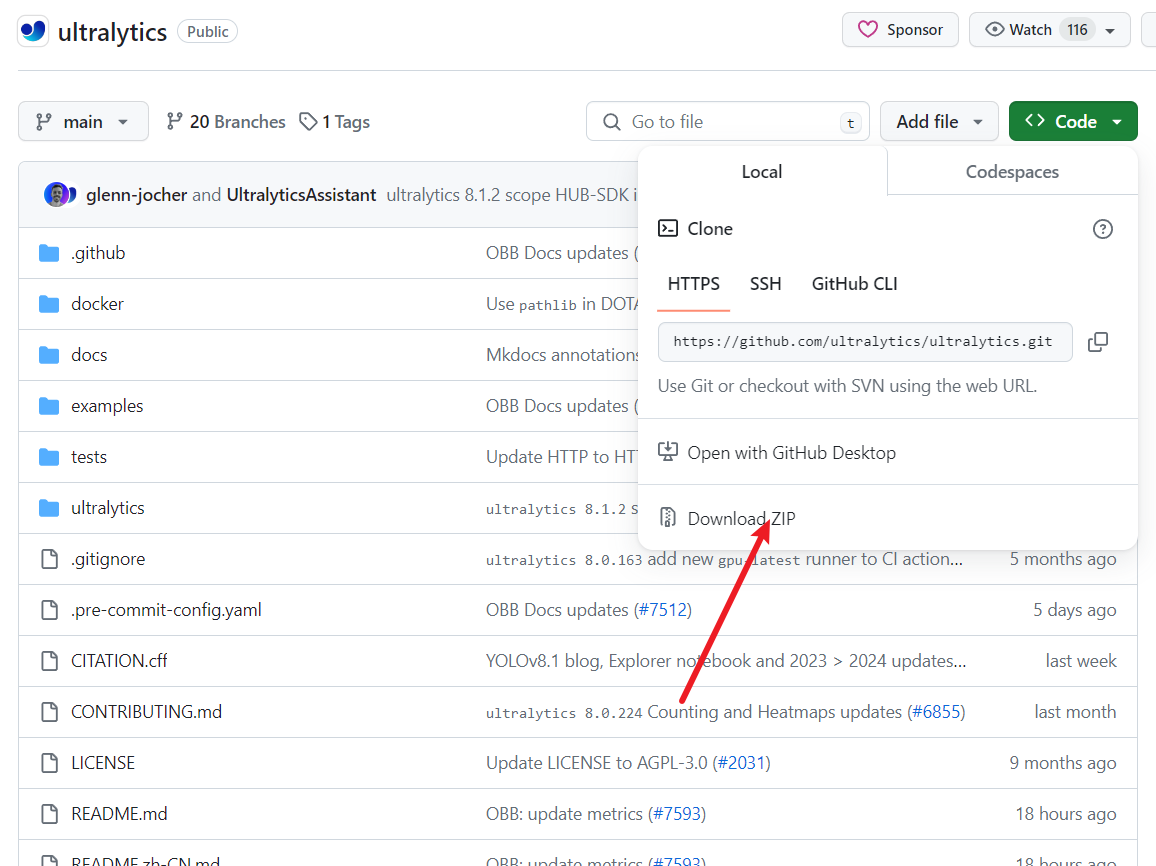
Git Clone
git clone https://github.com/ultralytics/ultralytics
安装环境
进入代码根目录并安装依赖。
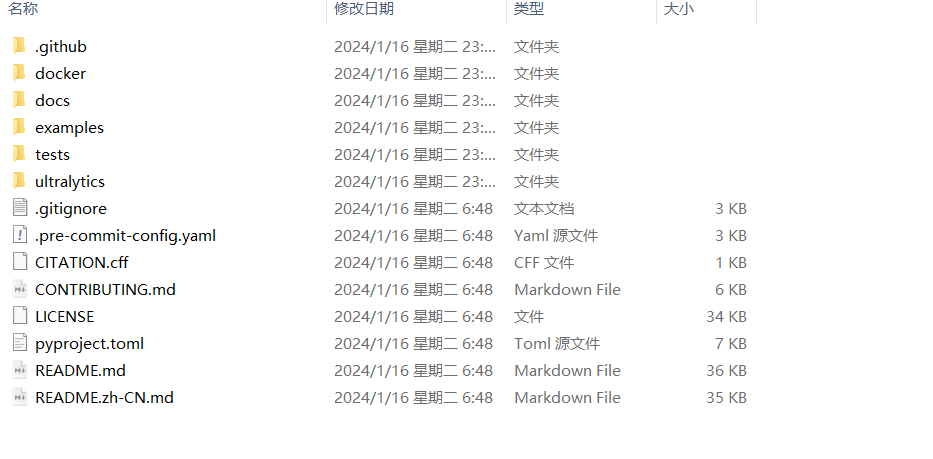
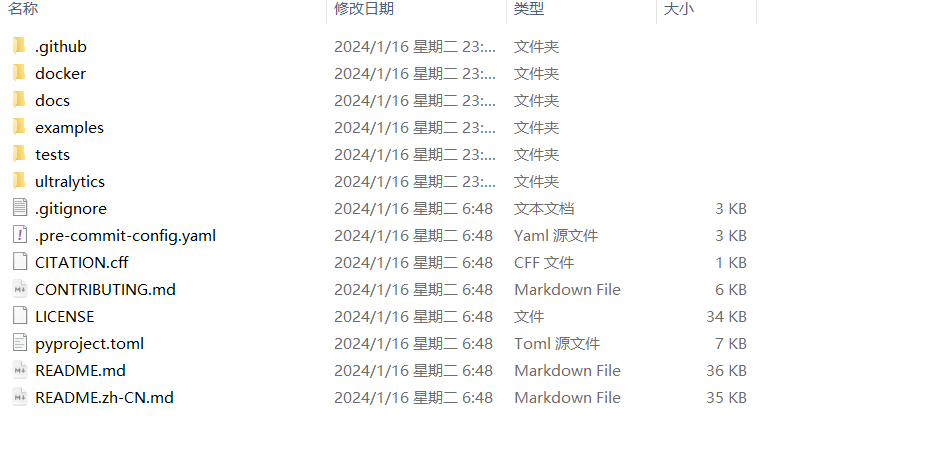
pip install -r requirements.txt -i https://pypi.tuna.tsinghua.edu.cn/simple
在最新版本中,官方已经废弃了requirements.txt文件,转而将所有必要的代码和依赖整合进了ultralytics包中。因此,用户只需安装这个单一的ultralytics库,就能获得所需的全部功能和环境依赖。
pip install ultralytics
引入代码
在根目录下的ultralytics/nn/目录,新建一个 backbone目录,然后新建一个以 ConvNeXt为文件名的py文件, 把代码拷贝进去。
import math
from torch import nn
import torch
from timm.models.layers import trunc_normal_, DropPath
import torch.nn.functional as F
class ConvNeXt_Stem(nn.Module):
def __init__(self, c1, c2, k=1, s=1, p=None, g=1, d=1, act=True):
super().__init__()
self.conv = nn.Conv2d(c1, c2, k, s, groups=g, dilation=d)
self.ln = LayerNorm(c2, eps=1e-6, data_format="channels_first")
def forward(self, x):
return self.ln(self.conv(x))
class ConvNeXt_Downsample(nn.Module):
def __init__(self, c1, c2, k=1, s=1, p=None, g=1, d=1, act=True):
super().__init__()
self.conv = nn.Conv2d(c1, c2, k, s, groups=g, dilation=d)
self.ln = LayerNorm(c1, eps=1e-6, data_format="channels_first")
def forward(self, x):
return self.conv(self.ln(x))
class ConvNeXt_Inside_Block(nn.Module):
def __init__(self, dim, layer_scale_init_value=1e-6, drop_path=0.): # ch_in, ch_out, number, shortcut, groups, expansion
super().__init__()
self.dwconv1 = nn.Conv2d(dim, dim, kernel_size=7, padding=3, groups=dim) # depthwise conv
self.norm = LayerNorm(dim, eps=1e-6)
self.pwconv1 = nn.Linear(dim, 4 * dim) # pointwise/1x1 convs, implemented with linear layers
self.act = nn.GELU()
self.pwconv2 = nn.Linear(4 * dim, dim)
self.gamma = nn.Parameter(layer_scale_init_value * torch.ones((dim)),
requires_grad=True) if layer_scale_init_value > 0 else None
self.drop_path = DropPath(drop_path) if drop_path > 0. else nn.Identity()
def forward(self, x):
input = x
x = self.dwconv1(x)
x = x.permute(0, 2, 3, 1) # (N, C, H, W) -> (N, H, W, C)
x = self.norm(x)
x = self.pwconv1(x)
x = self.act(x)
x = self.pwconv2(x)
if self.gamma is not None:
x = self.gamma * x
x = x.permute(0, 3, 1, 2) # (N, H, W, C) -> (N, C, H, W)
x = input + self.drop_path(x)
return x
class ConvNeXt_Block(nn.Module):
def __init__(self, c1, c2, n=1, layer_scale_init_value=1e-6):
super().__init__()
self.m = nn.Sequential(*(ConvNeXt_Inside_Block(c2, layer_scale_init_value) for _ in range(n)))
self.apply(self._init_weights)
def _init_weights(self, m):
if isinstance(m, (nn.Conv2d, nn.Linear)):
trunc_normal_(m.weight, std=.02)
nn.init.constant_(m.bias, 0)
def forward(self, x):
x = self.m(x)
return x
class LayerNorm(nn.Module):
r""" LayerNorm that supports two data formats: channels_last (default) or channels_first.
The ordering of the dimensions in the inputs. channels_last corresponds to inputs with
shape (batch_size, height, width, channels) while channels_first corresponds to inputs
with shape (batch_size, channels, height, width).
"""
def __init__(self, normalized_shape, eps=1e-6, data_format="channels_last"):
super().__init__()
self.weight = nn.Parameter(torch.ones(normalized_shape))
self.bias = nn.Parameter(torch.zeros(normalized_shape))
self.eps = eps
self.data_format = data_format
if self.data_format not in ["channels_last", "channels_first"]:
raise NotImplementedError
self.normalized_shape = (normalized_shape,)
def forward(self, x):
if self.data_format == "channels_last":
return F.layer_norm(x, self.normalized_shape, self.weight, self.bias, self.eps)
elif self.data_format == "channels_first":
u = x.mean(1, keepdim=True)
s = (x - u).pow(2).mean(1, keepdim=True)
x = (x - u) / torch.sqrt(s + self.eps)
x = self.weight[:, None, None] * x + self.bias[:, None, None]
return x
注册
在ultralytics/nn/tasks.py中进行如下操作:
步骤1:
from ultralytics.nn.backbone.ConvNeXt import ConvNeXt_Stem, ConvNeXt_Block, ConvNeXt_Downsample
步骤2
修改def parse_model(d, ch, verbose=True):
elif m in (ConvNeXt_Stem, ConvNeXt_Block, ConvNeXt_Downsample):
c1, c2 = ch[f], args[0]
if c2 != nc: # if c2 not equal to number of classes (i.e. for Classify() output)
c2 = make_divisible(min(c2, max_channels) * width, 8)
args = [c1, c2, *args[1:]]
if m is ConvNeXt_Block:
args.insert(2, n) # number of repeats
n = 1
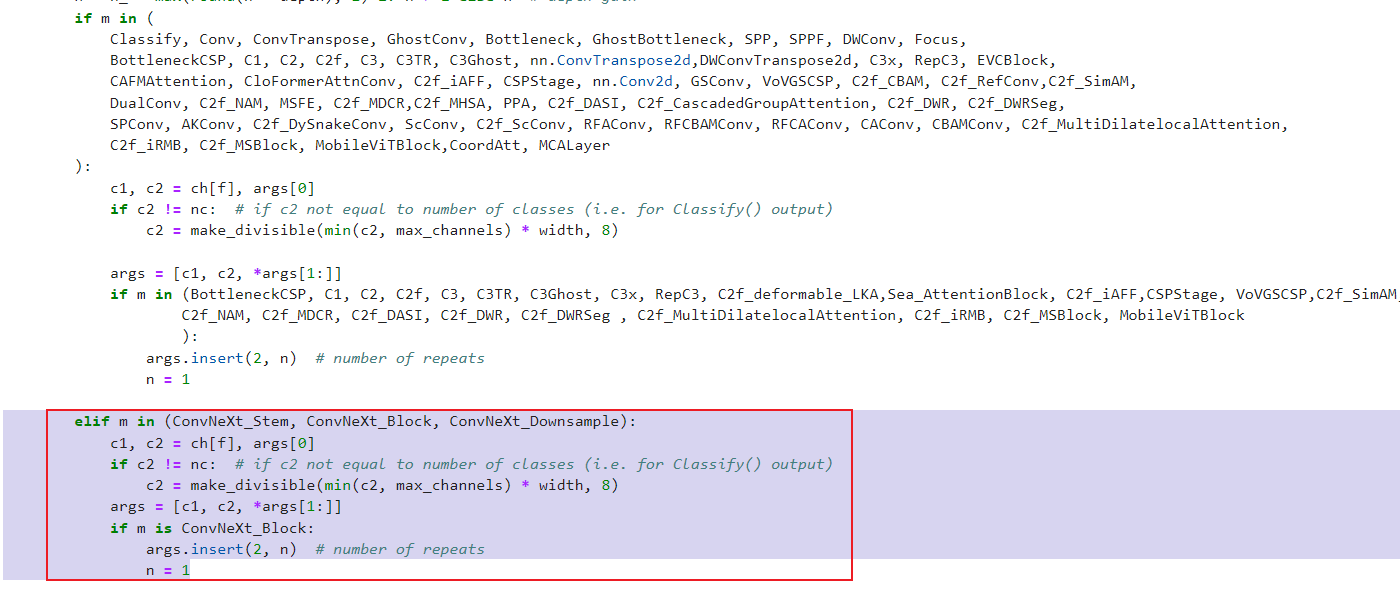
配置yolov8_ConvNeXt.yaml
ultralytics/cfg/models/v8/yolov8_ConvNeXt.yaml
# Ultralytics YOLO 🚀, AGPL-3.0 license
# YOLOv8 object detection model with P3-P5 outputs. For Usage examples see https://docs.ultralytics.com/tasks/detect
# Parameters
nc: 80 # number of classes
scales: # model compound scaling constants, i.e. 'model=yolov8n.yaml' will call yolov8.yaml with scale 'n'
# [depth, width, max_channels]
n: [0.33, 0.25, 1024] # YOLOv8n summary: 225 layers, 3157200 parameters, 3157184 gradients, 8.9 GFLOPs
s: [0.33, 0.50, 1024] # YOLOv8s summary: 225 layers, 11166560 parameters, 11166544 gradients, 28.8 GFLOPs
m: [0.67, 0.75, 768] # YOLOv8m summary: 295 layers, 25902640 parameters, 25902624 gradients, 79.3 GFLOPs
l: [1.00, 1.00, 512] # YOLOv8l summary: 365 layers, 43691520 parameters, 43691504 gradients, 165.7 GFLOPs
x: [1.00, 1.25, 512] # YOLOv8x summary: 365 layers, 68229648 parameters, 68229632 gradients, 258.5 GFLOPs
# YOLOv8.0n backbone
backbone:
# [from, repeats, module, args]
- [-1, 1, ConvNeXt_Stem, [96, 4, 4]] # 0-P2/4
- [-1, 3, ConvNeXt_Block, [96]]
- [-1, 1, ConvNeXt_Downsample, [192, 2, 2]] # 2-P3/8
- [-1, 3, ConvNeXt_Block, [192]]
- [-1, 1, ConvNeXt_Downsample, [384, 2, 2]] # 4-P4/16
- [-1, 9, ConvNeXt_Block, [384]]
- [-1, 1, ConvNeXt_Downsample, [768, 2, 2]] # 6-P5/32
- [-1, 3, ConvNeXt_Block, [768]]
# YOLOv8.0n head
head:
- [-1, 1, nn.Upsample, [None, 2, 'nearest']]
- [[-1, 5], 1, Concat, [1]] # cat backbone P4
- [-1, 3, C2f, [384]] # 10
- [-1, 1, nn.Upsample, [None, 2, 'nearest']]
- [[-1, 3], 1, Concat, [1]] # cat backbone P3
- [-1, 3, C2f, [192]] # 13 (P3/8-small)
- [-1, 1, Conv, [256, 3, 2]] # p3
- [[-1, 10], 1, Concat, [1]] # cat head P4
- [-1, 3, C2f, [384]] # 16 (P4/16-medium)
- [-1, 1, Conv, [512, 3, 2]] # p4
- [[-1, 7], 1, Concat, [1]] # cat head P5
- [-1, 3, C2f, [768]] # 19 (P5/32-large)
- [[13, 16, 19], 1, Detect, [nc]] # Detect(P3, P4, P5)
实验
脚本
import os
from ultralytics import YOLO
yaml = 'ultralytics/cfg/models/v8/yolov8_ConvNeXt.yaml'
model = YOLO(yaml)
model.info()
if __name__ == "__main__":
results = model.train(data='coco128.yaml',
name='yolov8_ConvNeXt',
epochs=10,
workers=8,
batch=1)
结果

文章目录























 1144
1144











 被折叠的 条评论
为什么被折叠?
被折叠的 条评论
为什么被折叠?










